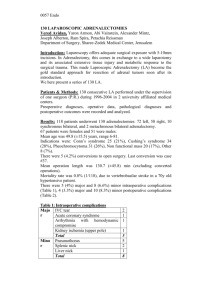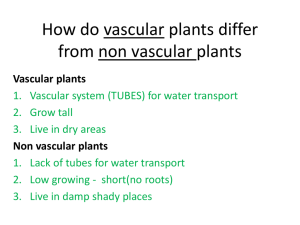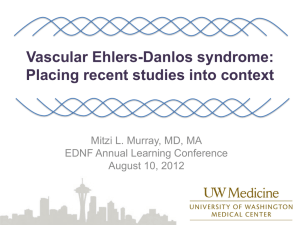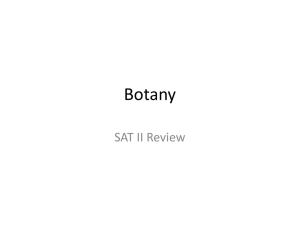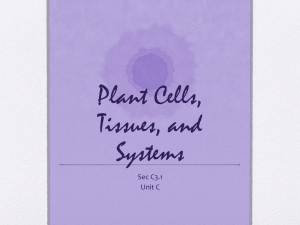Recognition and Management of Vascular Injuries Reza Ghavamian
advertisement
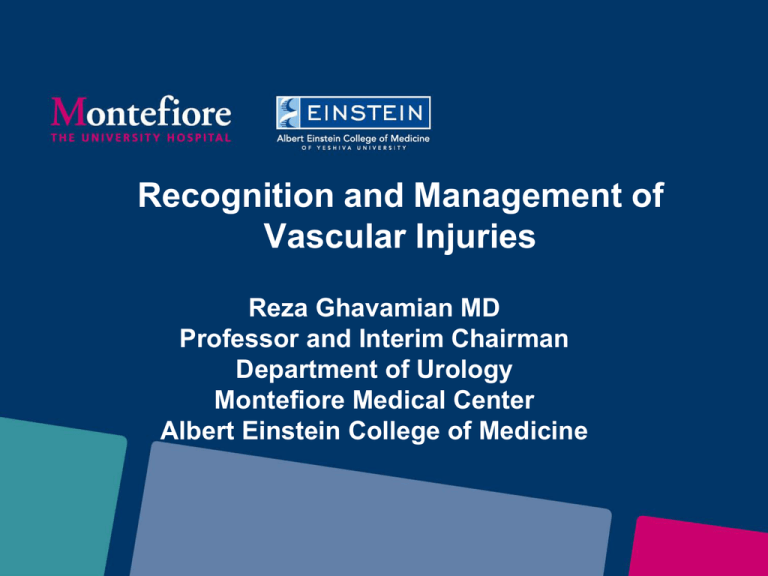
Recognition and Management of Vascular Injuries Reza Ghavamian MD Professor and Interim Chairman Department of Urology Montefiore Medical Center Albert Einstein College of Medicine Laparoscopic Complications Colombo & Gill et al: Single institution analysis 2007: 1867 procedures • intraoperative 3.5% • Postoperative 8.9% • Mortality 0.4% Associated with more complications: • lap cystectomy, partial nephrectomy • Length of surgery >4hrs • Serum Cr> 1.5mg/dl • Hemorrhage most common complication intraop and postop • Complications decrease with surgeon experience Colombo JR et al: J Urol 178: 786-791, 2007. WHY COMPLICATIONS? Experience: 4 fold Complexity: 9 fold Patient risk: if > 100 cases if more complex As ASA increases so does risk of complications. (Fahlenkamp, D. et al.: J. Urol. 162: 765, 1999 – 2,407 cases) (Parsons, J. et al.: Urology: 63: 27, 2004 – 894 cases) A PLEA FOR CONFORMITY IN REPORTING COMPLICATIONS Clavien System: I: Any deviation for a normal postoperative course without need for any intervention or medication II: Need for medications, blood transfusion, or parenteral nutrition IIIa: Intervention – without general anesthesia III b: IVa: IVb: V: Intervention – with general anesthesia Life threatening, Single organ dysfunction Multiple organ dysfunction Death (I, II, and IIIa are largely minor whereas IIIb and IV would be considered major complications) (Dindo,D., Clavien, P. et al.: Ann. Surg. 240: 205, 2004) COMPLICATIONS 1. 2. 3. 4. Entry Pneumoperitoneum Intraoperative Postoperative a. Early b. Late Access Related Complications Michael Stifelman M.D. ENTRY: 1. Initial access 2. Trocars ENTRY A good beginning is essential: “More than one half of the complications related to laparoscopy are related to the entry technique.” Incidence: 0.3 – 1.0% (Magrina, J. F.: Clin. Ob. and Gyn. 45: 469, 2002) (meta-analysis: 1,549,360 laparoscopic cases) ENTRY INJURIES Veress or Open? Veress (n= 12,444) Vascular injury: Bowel injury: Gas embolism: Death: Open (n= 489,335) 0.08% 0.08% 0.001% 0.003% *p < .05; (Bonjer, H: Br. J. Surg. 84: 599, 1997) (N.B.: other prospective studies showed no difference!) 0.0%* 0.05% 0.0% 0.0% Access Related Complications (0.03 – 1%) • Extraperitoneal insertion • Vascular injury – Abdominal wall vessels – Retroperitoneal vessels – Mesenteric vessels • Visceral injury – Stomach, bowel, liver, spleen, bladder Options for Gaining Intraperitoneal Entry: • Closed puncture technique- Veress needle (highest injury rate) FOR THE NOVICE!! • Hassan Technique • Hand-Assist access first – Insert additional trocars with hand in abdomen Strategies to avoid access-related complications: • Use Hassan technique or make handassist device incision • Use visual introducing trocars when using Veress • Always verify Veress needle position Saline drop test Move 1-1.5 cm insufflation pressure VERESS NEEDLE • The operator should feel or sense the needle passing through two distinct planes. • The needle is advanced and withdrawn several times. If this is done easily and without obstruction, the tip is in proper position. TRANSPERITONEAL STANDARD ENTRY Veress needle: • Test needle prior to placement. • Aspirate, irrigate, aspirate (then irrigate)…drop test and advancement test. Needle rotation. • “If in doubt, pull it out.” (High pressure and low flow, remove needle.) Tip: Increase abdominal pressure to 25 mm Hg for initial trocar placement. TRANSPERITONEAL STANDARD ENTRY Open cannula: • Place in an unscarred area of the abdomen. • Finger to palpate underside of peritoneum 360 degrees, to insure absence of adherent bowel, etc. • Use the balloon trocar – reduces any leak or subcutaneous emphysema WHERE’S THE BEST PLACE? Entry sites: 5! Umbilical (Danger – IVC/Aorta) Right (Palmer’s point) or Left MCL subcostal (Danger – Liver or Liver/spleen) Right or Left side AAL – 2 fingerbreadths above the iliac crest (Danger – colon) (Don’t hesitate to go left when you are operating right!) (McDonald, D., et al.: SLEPT 15: 325, 2005) INTRAOPERATIVE COMPLICATIONS The BIG 3: 1. Cardiac arrest 2. Vascular 3. Bowel The others: Spleen, Liver, Pancreas, Bladder, Ureter, Diaphragm, Instrumentation, Oliguria Intra-abdominal Vascular Injury: • Ensure skin incision wide enough • If Veress aspirate • Consider visual obturator • If bleeding suspected – Leave veress/trocar in place – Place accessory ports • Beware of hematoma obscuring injury Intraoperative Vascular Injuries VASCULAR INJURY Overview: Incidence: 0.5 – 2.8% Conversion: 50% Mortality: 9-17% Mechanism: 1. Veress needle: 38% 2. Trocar: 45% 3. Intraoperative: 17% (Hashizume, M.: Japan. Surg. Endosc. 11: 1198, 1997; Chapron, C. M., J. Am. Coll. Surg. 185: 461, 1997; Mintz, M. :J. Reprod. Med. 18: 269, 1997; Yuzpe, A.: J. Reprod. Med. 35: 485, 1990; Magrina, J. : Clin. Obstet. and Gyn. 45 469, 2002; Parsons, J. et al.: Urology: 63: 27, 2004) PROBLEM: INTRAOPERATIVE HEMORRHAGE Prevention: • 5.5-6 cm. off the midline to avoid the epigastric vessels* • “In order to operate fast, it is necessary to go slow.” G. Vallancien • Think twice … cut once. • Liberal use of energy devices (harmonic, Ligasure) • Blunt ports • Abdominal inspection at 5 mm Hg: look for “rivulets – red swirls” • Port removal under vision at 5 mm Hg *(Hashizume, M.: Japan. Surg. Endosc. 11: 1198, 1997) TROCAR INJURY: ABDOMINAL WALL The most common site is from the inferior and superior epigastric vessels. The overall incidence is 0.5% Key point: Lateral ports should be at least 5.5-6 cm. off the midline to avoid the epigastric vessels. (Hashizume, M.: Japan. Surg. Endosc. 11: 1198, 1997) Intraoperative Vascular Injuries • Risk 2-3% • Can occur due to the proximity of the operation to the great vessels in the upper tract • Proximity to the iliac vessels in the pelvis • Be prepared (extra suction, open basic laparotomy tray) • Prompt recognition key • Cut only what you see • Gentle handling of instruments • Control your assistant • Always orient yourself Intraoperative Vascular Injuries Steps: • Transient increase in abdominal pressure to 20-25 mmHg and maintain pneumoperitoneum • Direct pressure with gauze (rolled 4x4) or rolled surgicel and suction irrigator • If under control assess extra trocars • Obtain optimal exposure, assess what is bleeding, isolate site • If possible avoid clips or hem-o-locks • Judicious use of : Lapra-Ty, Ligasure, laparoscopic Statinsky, surgical glues • Free hand suturing best!! (just like open) Intraoperative Vascular Injuries • Low treshold to open • Transfuse as necessary • Have vascular and abdominal tray available There is no shame in conversion! • Exposure • Pressure, pack, transfuse needed • Obtain vascular consult if necessary PROBLEM: INTRAOPERATIVE HEMORRHAGE Management: • Raise pneumoperitoneum pressure to 25 mm Hg • Tamponade (rolled 4 x 4 / Satinsky) • Hydrate - transfuse • Identify what is bleeding! • Small - electrosurgery or harmonic +/- fibrin glue / gelfoam / Floseal • Large – get blood / call Vascular surgery /suture (EndoStitch/LaparoTy clip/free hand) +/- fibrin glue / gelfoam / Floseal WHEN AND HOW TO CONVERT: 1. Tamponade site of bleeding. 2. Open set and blood in the room 3. Second suction unit set up 4. Call out for vascular surgery 5(a). Convert to hand-assist or 5(b). Open: swing endoscope up to underside of abdomen and incise on endoscope; rapidly pack site of bleeding HEMOSTASIS FloSEAL: Collagen derived granules and topical thrombin. Indications: capillary to arterial bleeding – works on actively bleeding tissues. Package to patient: 2 min. (Baxter BioScience) INTRAOPERATIVE COMPLICATIONS: INSTRUMENTATION Device Malfunction: Stapler Mayhem 1992-2001: FDA databases: Manufacturer and User Facility Device Experience + Alternative Summary Reporting database Mortalities: 112 Injuries: 2,180 Malfunction: 22,804 (Brown, S. and Woo, E.: J. Am Col. Surg. 199: 375, 2004) Movies HEMORRHAGE TRAY Contents: • • • • • • • • • Laparoty clip applier Set of LaparoTy clip 2 needle holders Endostitch 4-0 Vicryl Klein bulldogs + Klein applicator Satinsky Surgicel Bolsters 4-0 silk on CV needle Endostitch LaparoTy clip Take Home Message: – Major vascular injury is a rare but serious complication that occurs in 0.11% to 2% of cases, most frequently involving the aorta and common iliac vessels • Campbell’s Urology, 2002 – Major vascular injury will present with sudden hypotension/ tachycardia and with rapid accumulation of blood in the abdominal cavity, a mesenteric hematoma, or a expanding retroperitoneal hematoma • Campbell’s Urology, 2002 – If bleeding is confined to the retroperitoneum, there may be very little blood intraperitoneally or none at all (thus presenting as an expanding retroperitoneal hematoma) • Usal et al, Surgical Endoscopy, 1998 Take Home Message: – Distance from the skin to the great vessels is only a few centimeters, especially in thin pts in a relaxed anesthetic state • Nordesgaard et al, Am J Surg, 1995 – When performing laparoscopy, must be aware of the potential for injury to major vascular structures and constantly be prepared to rapidly identify and treat this potentially life-threatening complication, with rapid location and control of site of injury and consideration of prompt exploratory laparotomy • Geers and Holden, Am Surg, 1996 PROBLEM: POSTOPERATIVE HEMORRHAGE Presentation: 1. Two forms: a. Acute: Sudden vascular collapse (hypotension (70s) /tachy) abd.distention b. Gradual: Mild hypotension (90s) with tachycardia 2. Persistent pulse / pain (Bhayani, S., Kavoussi, L., et al.: J. Urol. 175: 2137, 2006) Diagnostic studies: 1. Hct./Hgb a. Acute: > 10 point drop in hct. from immediate postop b. Gradual: > 5 point drop in hct. – / need for 5 unit transfusion within initial 24-36 hrs. 2. CT scan: (only for gradual group) Treatment: Exploration (lap. vs. open) check port site/op. site PROBLEM: POSTOPERATIVE HEMORRHAGE Results: “Acute” Results: “Gradual” 1. Incidence: 0.4% (4 out of 1,123 laparoscopic renal cases) 2. Approach: 3 open and 1 laparoscopic exploration - < 10 hrs. postop 3. Cause: 3 adrenal and one renal artery. 4. Hospital stay: 8 days 1. Incidence: 0.5% (5 out of 1,123 laparoscopic renal cases) 2. Approach: 1 open and 4 laparoscopic exploration – 12-38 hrs postop 3. Cause: No source seen – diffuse oozing. 4. Hospital stay: 12 days (Bhayani, S., Kavoussi, L., et al.: J. Urol. 175: 2137, 2006) PROBLEM: POSTOPERATIVE HEMORRHAGE Upper retroperitoneal procedures: Incidence: Units transfused: % explored: Risk factors: Hosp. stay: 0.4% (3.4% nephrectomy 5.4% adrenalectomy 9.9% partial nephrectomy) 56% (1-2) 38% (3-6) 6% (11 and 12) 12% (2 acute / 2 delayed*) Age and ASA classfication Intraoperative injury to spleen or liver 2.7 days *(patient restarted coumadin – bled on postop day 4 – PTT > 100) (Rosevear, H., Roberts, W., Wolf, J. et al.: J. Urol. 176: 1458-1462, 2006) Postoperative Vascular Injuries • Hct decreases by 7-10 points (due to oligiuria and excess ressucitation) Warning signs: • Postoperative pain • Abdominal distension and discomfort • Nausea • Tachycardia • Continued fall in Hct Treat with open or lap re-exploration depending on stability Assess further with CT scan if stable
